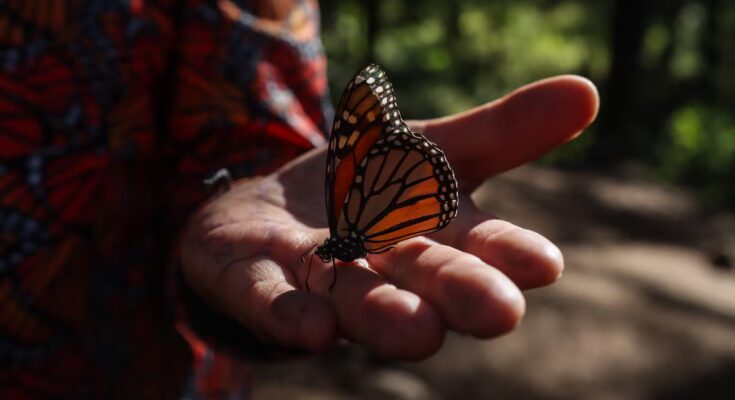On November 11, a monarch butterfly arrived home for the winter months: the forests between Michoacán and the State of Mexico. It had been more than a month since he left Ontario, Canada, and entered the United States, where he crossed southwest through the states of Ohio, Kentucky, Tennessee and Mississippi, before turning east into Louisiana and then crossing into Texas. In Ciudad Acuña, Coahuila, he crossed the border and traveled south, passing through Zacatecas, San Luis Potosí, Aguascalientes and Jalisco, before flying west and traveling through Michoacán towards the oyamel tree where he will sleep until spring. A journey of almost 3,000 kilometers to reach the Monarch Butterfly Biosphere Reserve, which in 2025 is the first time it can be known in such detail. The trick? This butterfly, like 499 others this year, has a tiny transmitter attached to its body.
𝐋𝐋𝐄𝐆𝐀 𝐃𝐄𝐒𝐃𝐄 𝐂𝐀𝐍𝐀𝐃𝐀́ 𝐋𝐀 𝐒𝐄𝐆𝐔𝐍𝐃𝐀 𝐌𝐀𝐑𝐈𝐏𝐎𝐒𝐀 𝐌𝐎𝐍𝐀𝐑𝐂𝐀 𝐂𝐎𝐍 𝐓𝐑𝐀𝐍𝐒𝐌𝐈𝐒𝐎𝐑 𝐀 𝐋𝐀 𝐑𝐄𝐒𝐄𝐑𝐕𝐀 𝐃𝐄 𝐋𝐀 𝐁𝐈𝐎𝐒𝐅𝐄𝐑𝐀 𝐌𝐀𝐑𝐈𝐏𝐎𝐒𝐀 𝐌𝐎𝐍𝐀𝐑𝐂𝐀 traveled +2,990km from📍Ontario🇨🇦 (Code PP0017) pic.twitter.com/B9fyYFhsDj
— Royal Mail Monarch Butterfly (@correorealmx) November 12, 2025
This transmitter is called BluMorpho, developed by the company Cellular Tracking Technologies and the Cape May Point Arts & Science Center, and weighs only 0.06 grams, we read in a text from the Xerces Society for Invertebrate Conservation, which helped test the chip. The novelty is that, while previous models could only be detected by special receivers, these interact with any mobile phone. Simply download the Project Monarch app and turn on the “Scan” option if you see a group of monarch butterflies flying nearby.
“Recently David La Puma, from the Cellular Tracking Technologies company, managed to develop a chip that can be inserted into monarch butterflies, very fragile and light so as not to create flight problems, using a special glue so that it remains throughout the entire migratory journey,” explains Jerónimo Chávez, from the Profauna organization, which helps monitor these butterflies. With this data, he says, it is possible to follow migration routes and see how they are altered by weather patterns. “With this technology, this year we saw how a monarch butterfly traveled along the east coast of the United States, crossed the Caribbean islands and entered Mexico through Veracruz,” explains Chávez. His team believes he will hibernate in Hidalgo.
Profauna are the organizers of Correo Real, one of its conservation programs, active since 1992. They have an educational axis and collaborate with organizations and governments in Mexico, the United States and Canada, but they also manage a citizen monitoring network, in which hundreds of people record and document the spring and autumn migrations of monarchs. Correo Real’s work was fundamental to understanding the migratory routes of butterflies within Mexico.
The monarch butterfly cycle begins in spring, on milkweed plants in the central and northern United States and southern Canada. In these plants, the only ones where they lay their eggs and the only source of food for the small caterpillars, several generations of monarchs are raised, until towards the end of summer, the decrease in hours of light and temperature gives birth to what they call the Methuselah generation. Unlike the previous ones, which die at six weeks, they live between eight and nine months, enough time to migrate and hibernate in Mexico, in the fir forests. They then move up to the United States, mainly to Texas, to lay the eggs of a first generation which will then return to the milkweed plants of the north-central United States and southern Canada. Through this migration they transfer pollen from flowering plants, helping the continent’s genetic diversity.
Right among the milkweed is where Dr. Karen Oberhause developed her citywide Monarch Larva Monitoring Project, which has been operating since 1996. “We have volunteers all over the United States, Canada and Mexico, who what they do is they monitor a milkweed spot once a week and they count how many monarch eggs and caterpillars there are,” Oberhause says. With 400 sites monitored each season, this allows them to see what the density of monarch butterflies is and what the survival rate is.
To become a contributor —community scientistthey call it in English, volunteers can be trained in in-person workshops organized annually by the project or with resources on its website, where they can also review all the data, from all points, since 1997.
“The reality is that the number of monarch butterflies is much smaller now,” laments Oberhause. “What’s interesting is that if we look at breeding sites, it hasn’t decreased by much; and we see the biggest change in Mexico, where fewer and fewer monarchs are able to overwinter, and that tells us that there’s less and less habitat for them to hibernate and fewer places for monarchs to breed,” he points out.
In Mexico, one of the methods to measure and compare the populations that arrive each winter is the hectares occupied in the zone of influence of the Monarch Butterfly Biosphere Reserve. With an area of 500 square kilometers, it was established in the 1980s and hosts forests of fir, pine, oak and cedar in several municipalities of the State of Mexico and Michoacán.
Every December and January, teams of technicians visit the hibernation area, measuring the surface area occupied by monarch butterflies. In 1996, a record year, there were 18 hectares of butterflies, while in 2013 the lowest point was reached, 0.67 hectares. That year, Canada, the United States and Mexico began working together to raise the amount. The efforts were effective and the population recovered, reaching six hectares in 2018, but has been declining ever since, returning to less than two hectares in 2024. The researchers attribute this to years of drought, which prevented the butterflies from finding sufficient resources for their migration, and a decline in international collaboration following the Covid-19 pandemic.
A recent study, The expansion of avocado monoculture threatens the monarch butterfly’s wintering habitat in central Mexicopredicts that the combination of climate change and rising avocado prices will put pressure on the Monarch Butterfly Biosphere Reserve. This article analyzes the expansion of the avocado from 2006 to 2024 within the reserve’s buffer zones, areas that are established around its core as a sort of shield, and hypothesizes different scenarios according to different climate models.
“With the current climate, we have seen that there are 5,000 hectares suitable for avocado cultivation,” explains one of the authors, Jesús Eduardo Sáenz-Ceja, doctor of biology and member of the Ecosystem and Sustainability Research Institute of the Autonomous University of Mexico. “If we include the variable of climate change, the area increases up to 10,000 hectares, since the higher areas, which are now cold or temperate, will cover the needs for avocado cultivation,” he warns. These new potential crop fields are forests.
Planting avocados, he warns, is not illegal, as long as it is done using sustainable production methods. “The problem is that 94% of producers do not comply and use pesticides.” Furthermore, of the 1,345 hectares of cultivation now found within the Reserve, 25% occurred through illegal land changes on old forests.
Some in Mexico try to anticipate the disappearance of ecosystems. Another article, entitled Establishing wintering sites for the monarch butterfly in future climates: expanding the upper altitudinal limit of the Abies religion through assisted migrationdescribes the efforts of a group of scientists from the University of Michoacán to plant fir trees in places that, in the next 40 years, will have a climate similar to that of the mountains of Michoacán, such as the Nevado de Toluca.
The plan is to create mature fir communities at higher elevations to offset the 2.3-degree temperature rise expected in 2060. At that point, if climate change prevents Michoacán’s forests from being home to the Methuselah monarchs, they will have trees to reach after migration and can continue to help the continent’s genetic diversity by transferring pollen from flower to flower.



